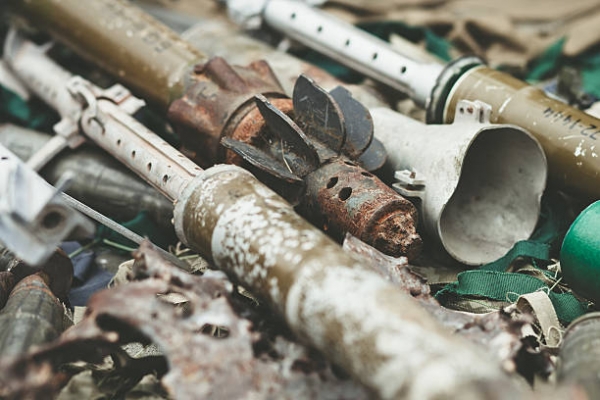The United Nations Mine Action Service (UNMAS) is a specialised service mandated by the General Assembly which works to eliminate the threat posed by landmines, Explosive Remnants of War (ERW) and Improvised Explosive Devices (IEDs). This report informs about the United Nations Mine Action Strategy 2019-2023 which aims to coordinate United Nations mine action, by leading operational responses at the country level, and supporting peace operations, also through the development of standards, policies and norms.
The UNMAS delivers a mine action against ERW and IEDs, which represents the major humanitarian challenge also because they can decimate nascent socio-economic development while undermining fragile peace. The UNMAS action takes place in 16 countries with an emergency setting and it is coordinated with the work of 140 local and international organizations focused on protection, health, education and food security to assist some 23 million people in need of mine action assistance. Indeed, civilians continue to suffer from explosive violence, especially in countries with ongoing conflicts or countries in which peacebuilding processes are ongoing. Therefore, explosive ordnance risk education (EORE) is a lifesaving activity and UNMAS works to raise awareness about the risks and safety measures also related to small arms and light weapons that are increasingly prevalent in countries such as Libya. As mentioned before, threats to civilians remain even after the signing of a peace treaty, thus, mine action can play a confidence-building role in peace and political processes. An example is Colombia where the UNMAS mine action is a component of the 2016 peace agreement. Moreover, mine action can be a catalyst for the socio-economic development of conflict countries, such as Somalia or Democratic Republic of Congo, where clearance activities facilitated the release of land for infrastructure development and agricultural activities. Furthermore, as a core pillar of mine action, UNMAS also assists survivors of explosive ordnance accidents with first response and rehabilitation services.
Besides, UNMAS operations took place within the framework of the United Nations Peace Operations. For instance, UNMAS supports the United Nations Mission for the Referendum in Western Sahara ensuring safe passage of the mission operators and by rendering minefields and cluster munition strike areas safe. In the United Nations Multidimensional Integrated Stabilization Mission In The Central African Republic (MINUSCA) UNMAS activities in 2020 focused particularly on protecting civilians and mitigating illicit flows of small arms and light weapons. UNMAS also acted in Mali, since its central regions are the most affected by IED incidents accounting for 53% of the 169 IED incidents recorded in 2020. Indeed, according to the report, despite the reduction in civilian casualties from IEDs in recent years (from 233 in 2018 to 178 in 2020), civilians remain the most vulnerable group, representing 49% of total casualties. In response, UNMAS supported the establishment of a national mine action authority to strengthen the activities of the UN mission and to mitigate the threat posed by IEDs. Cyprus too is one of the areas in which the UNMAS operates since explosive threats are present although the conflict has ended, thus UNMAS supports the UN peacekeeping force to safely maintain the ceasefire in the island. UNMAS also helped the return of civilians in their communities in Abyei through clearance activities. For instance, 560 km of roads and almost 700,000 sq m of land in the Abyei area have been declared safe from explosive ordnance. Furthermore, some 3,000 men, women, boys and girls, including nomadic people and returning Internally Displaced Persons and refugees have been reached by UNMAS risk education activities. The UNMAS clearance activities also supported the post-conflict stabilisation and reconstruction in South Sudan where the clearance of roads and land enabled the delivery of humanitarian assistance and the construction of schools, markets and water points. Indeed, in 2020, UNMAS removed and destroyed over 35,000 ERW, including landmines, and surveyed and/or cleared almost 2,000 hazardous areas contaminated by landmines and unexploded ordnance. In addition, UNMAS surveyed and cleared just over 730 km of road on routes and raised awareness among 125,000 South Sudanese people. Besides, UNMAS supported the African Union Mission in Somalia (AMISOM), being one of the most complex conflict situations, by providing specialized training to AMISOM troops. Indeed, AMISOM personnel together with the Somalia National Army (SNA) suffered from IED incidents, for instance the SNA recorded 206 fatalities and 321 injuries in 130 IED incidents this year. Still, the specialized training reduced the impact of these incidents on AMISOM personnel.
As a result, in its 19 programmes around the world, the UNMAS destroyed 71,000 explosive remnants of war, 900 landmines, and 400 IEDs together with 69 sq km of land and 1,900 km or roads that have been rendered safe. Nevertheless, the COVID-19 pandemic changed the humanitarian landscape dramatically in 2020 impacting the UNMAS resource mobilisation efforts. Indeed, many states reprioritized their budgets to face the sanitary emergency negatively impacting UNMAS programmes. Therefore, adequate funding is needed by UNMAS to focus resources on areas of great need.
To know more, please read:
https://reliefweb.int/sites/reliefweb.int/files/resources/unmas_annual_report_2020_1.pdf
Author: Eleonora Gonnelli; Editor: Benedetta Spizzichino




